engine Lexus GS350 2007 Using the front audio system / LEXUS 2007 GS430/350 (OM30A04U) Owner's Guide
[x] Cancel search | Manufacturer: LEXUS, Model Year: 2007, Model line: GS350, Model: Lexus GS350 2007Pages: 562, PDF Size: 17.95 MB
Page 72 of 562

52
1-6. Anti-theft system
Engine immobilizer system
■System maintenance
The vehicle has a maintenance-free type of engine immobilizer system.
■Conditions that may cause the system to malfunction
●If the grip portion of the key is in contact with a metallic object.
●If the key is in close proximity to or touching a key to the security system (key
with a built-in transponder chip) of another vehicle.
■Certifications for the engine immobilizer system For vehicles sold in the U.S.A.
This device complies with Part 15 of the FCC Rules. Operation is subject to the fol -
lowing two conditions: (1) this device may not cause harmful interference, and (2)
this
device must accept any interference received, including interference that may
cause undesired operation.
For vehicles sold in Canada
Operation is subject to the following two co
nditions: (1) this device may not cause
interference, and (2) this device must accept any interference, including interfer -
ence that may cause undesired operation of the device.
The vehicle's keys have built-in transponder chips that prevent the engine
from starting if the key has not been previously registered in the vehicle's
on-board computer.
Never leave the keys inside the vehicle when you leave the vehicle.
The indicator light flashes after
the engine switch has been
turned “OFF” to indicate that
the system is operating.
FCC ID: NI4TMIMB-1
Page 73 of 562

53
1-6. Anti-theft system
1
Before driving
CAUTION
■Certifications for the engine immobilizer system
Changes or modifications not expressly approved by the party responsible for
compliance could void the user’s authority to operate the equipment.
NOTICE
■For proper system operation
Do not modify, remove or disable the engine immobilizer system. If any unautho-
rized changes or modifications are made, the proper operation of the system can-
not be guaranteed.
Page 74 of 562
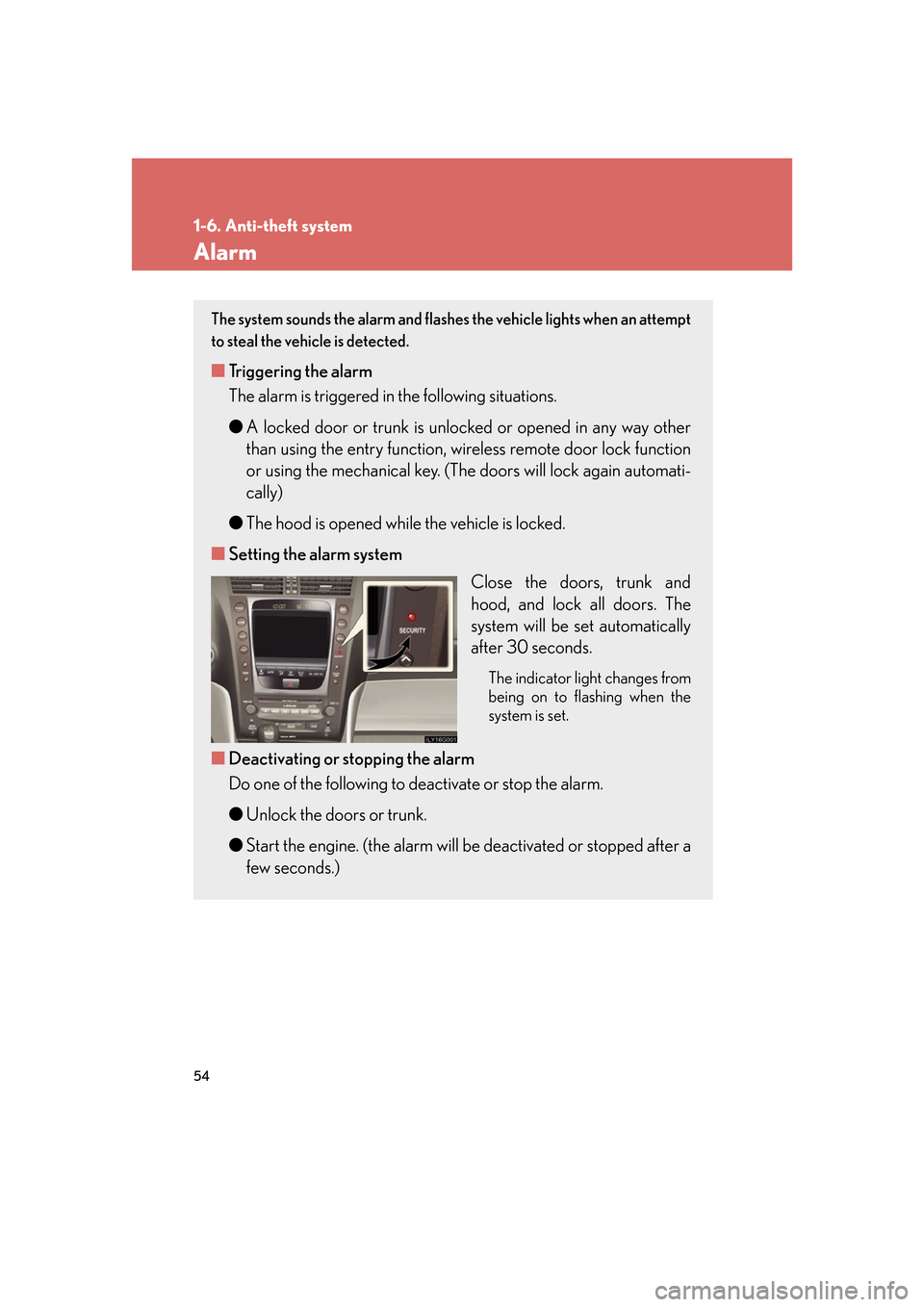
54
1-6. Anti-theft system
Alarm
The system sounds the alarm and flashes the vehicle lights when an attempt
to steal the vehicle is detected.
■ Triggering the alarm
The alarm is triggered in the following situations.
●A lock
ed door or trunk is unlocked or opened in any way other
than using the entry function, wire less remote door lock function
or using the mechanical key. (The doors will lock again automati -
cally)
● The hood is opened while the v
ehicle is locked.
■ Setting the alarm sy
stem
Close the doors, trunk and
hood, and lock all door
s. The
system will be set automatically
after 30 seconds.
The indicator light changes from
being on to flashing when the
system is set.
■ Deactivating or stopping the alarm
Do one of the following to deactivate or stop the alarm.
●Unlock the doors or trunk.
● Star
t the engine. (the alarm will be deactivated or stopped after a
few seconds.)
Page 109 of 562
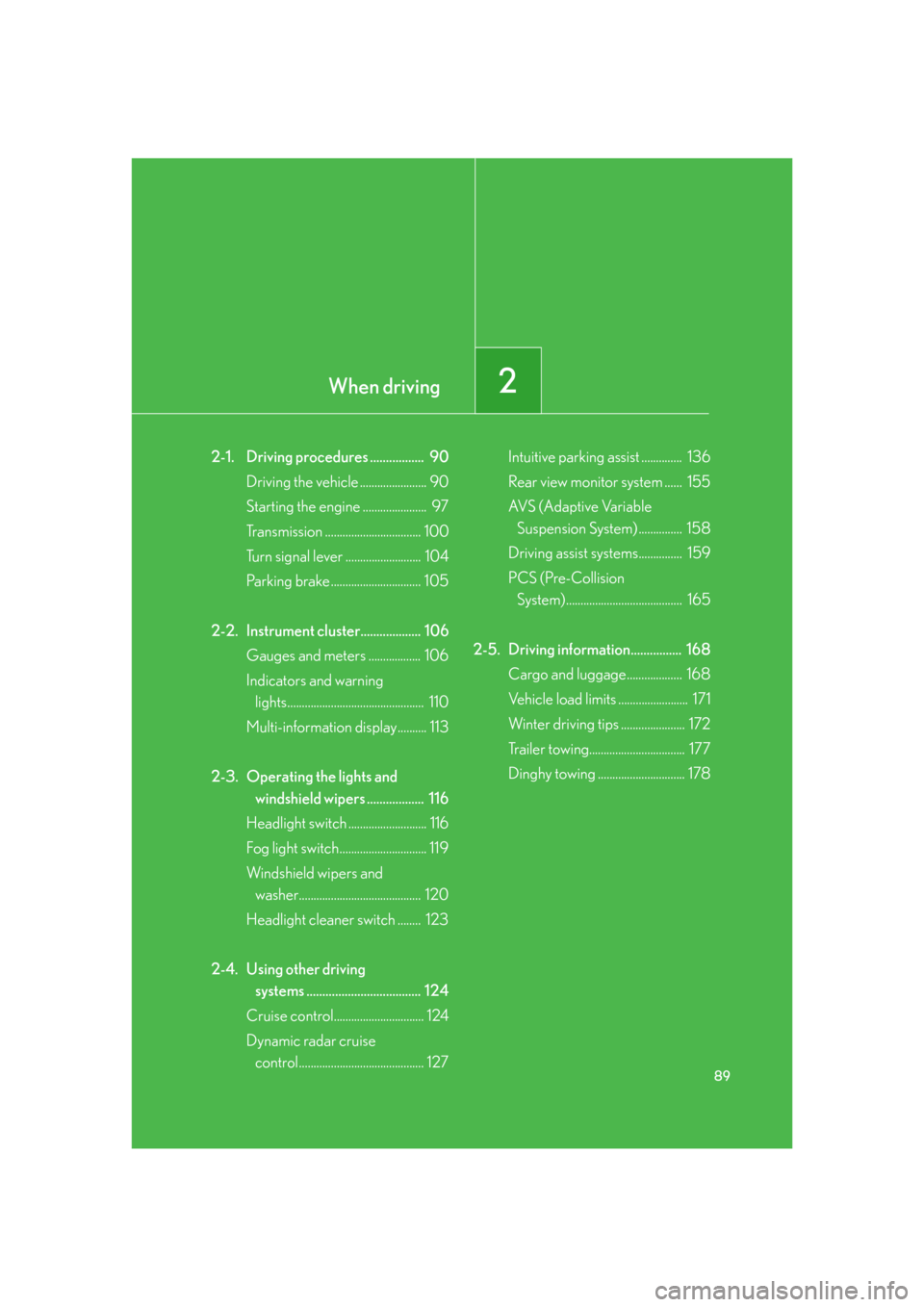
When driving2
89
2-1. Driving procedures ................. 90Driving the vehicle ....................... 90
Starting the engine ...................... 97
Transmission ................................. 100
Turn signal lever .......................... 104
Parking brake ............................... 105
2-2. Instrument cluster................... 106 Gauges and meters .................. 106
Indicators and warning
lights............................................... 110
Multi-information display.......... 113
2-3. Operating the lights and
windshield wipers .................. 116
Headlight switch ........................... 116
Fog light switch.............................. 119
Windshield wipers and
washer.......................................... 120
Headlight cleaner switch ........ 123
2-4. Using other driving
systems .................................... 124
Cruise control............................... 124
Dynamic radar cruise
control........................................... 127 Intuitive parking assist .............. 136
Rear view monitor system ...... 155
AVS (Adaptive Variable
Suspension System) ............... 158
Driving assist systems............... 159
PCS (Pre-Collision
System)........................................ 165
2-5. Driving information................ 168 Cargo and luggage................... 168
Vehicle load limits ........................ 171
Winter driving tips ...................... 172
Trailer towing................................. 177
Dinghy towing .............................. 178
Page 110 of 562

90
2-1. Driving procedures
Driving the vehicle
Starting on a steep incline
Firmly set the parking brake and shift the shift lever to “D”.
Gently depress the accelerator pedal.
Release the parking brake.
The following procedures should be observed to ensure safe driving.
■ Starting the engine ( P. 9 7 )
■ Driving
With the brake pedal depressed, shift the shift lever to “D”.
( P
. 100)
Release the parking brake. (P
. 105)
Gradually release the brake peda l and gently push the accel-
erator pedal to accelerate the vehicle.
■ Stopping
With the shift lever in “D”, push the brake pedal.
If necessary, set the parking brake.
When the vehicle is stopped for an extended period of time, shift the
shift lever to “P”. (
P. 100)
■Parking the vehicle
With the shift lever in “D”, push the brake pedal.
Set the parking brake. (P. 1 0 5 )
Shift the shift lever to “P”. ( P. 1 0 0 )
Stop the engine.
Lock the door, making sur
e that you have the electronic key on
your person.
STEP1
STEP2
STEP3
STEP1
STEP2
STEP1
STEP2
STEP3
STEP4
STEP5
STEP1
STEP2
STEP3
Page 112 of 562
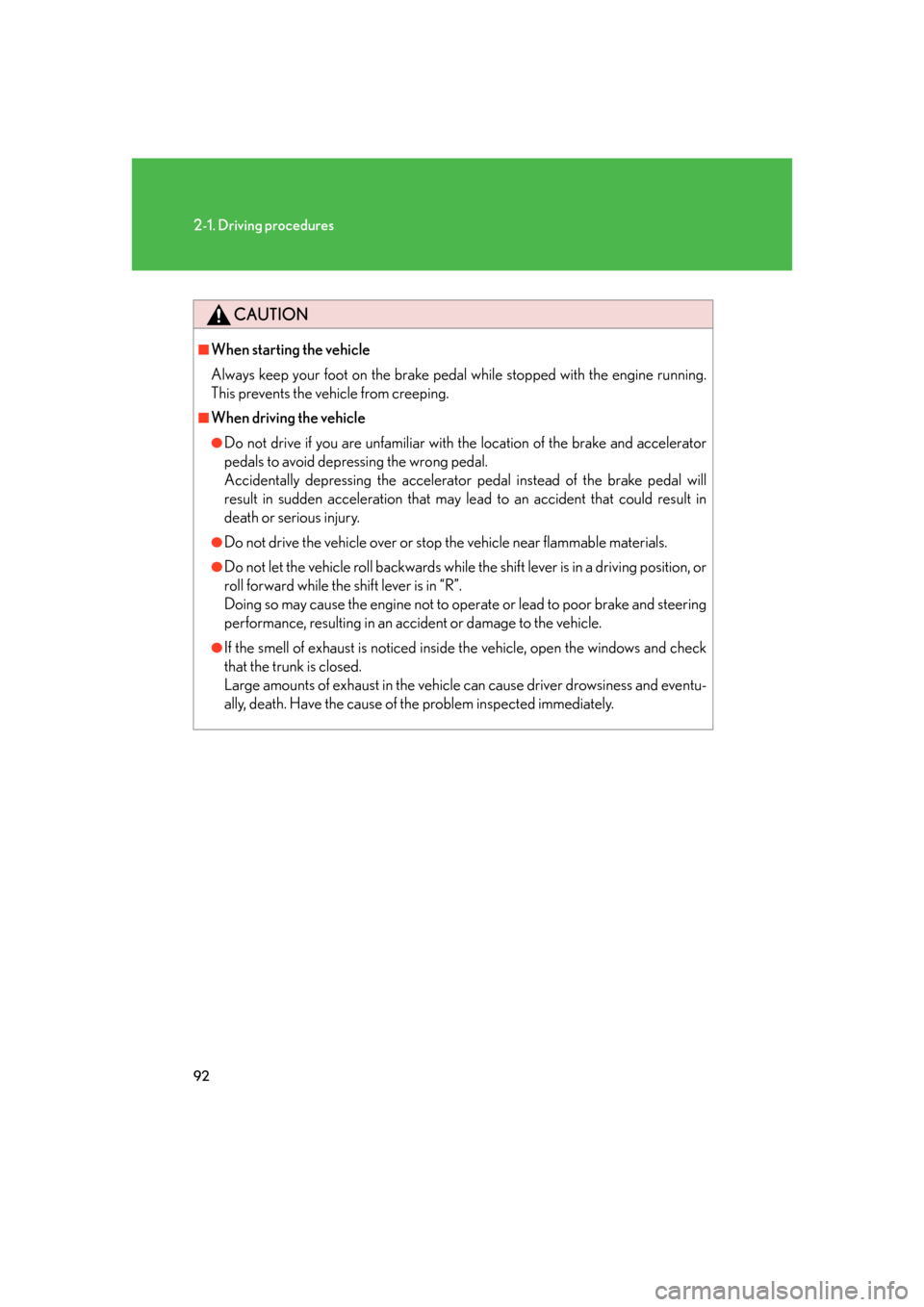
92
2-1. Driving procedures
CAUTION
■When starting the vehicle
Always keep your foot on the brake pedal while stopped with the engine running.
This prevents the vehicle from creeping.
■When driving the vehicle
●Do not drive if you are unfamiliar with the location of the brake and accelerator
pedals to avoid depressing the wrong pedal.
Accidentally depressing the accelerator pedal instead of the brake pedal will
result in sudden acceleration that may lead to an accident that could result in
death or serious injury.
●Do not drive the vehicle over or stop the vehicle near flammable materials.
●Do not let the vehicle roll backwards while the shift lever is in a driving position, or
roll forward while the shift lever is in “R”.
Doing so may cause the engine not to oper ate or lead to poor brake and steering
performance, resulting in an accident or damage to the vehicle.
●If the smell of exhaust is noticed inside the vehicle, open the windows and check
that the trunk is closed.
Large amounts of exhaust in the vehicle can cause driver drowsiness and eventu-
ally, death. Have the cause of the problem inspected immediately.
Page 113 of 562
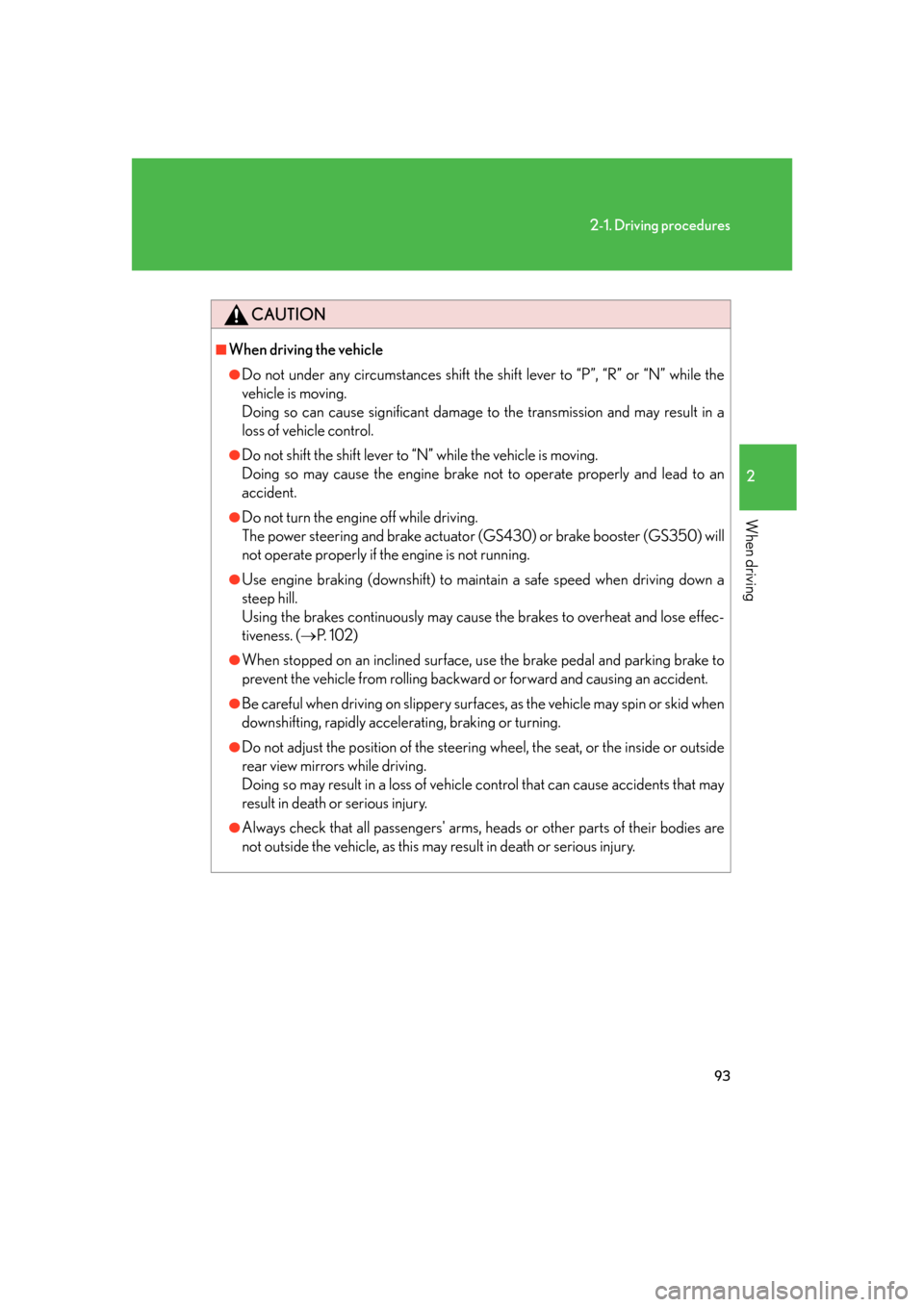
93
2-1. Driving procedures
2
When driving
CAUTION
■When driving the vehicle
●Do not under any circumstances shift the shift lever to “P”, “R” or “N” while the
vehicle is moving.
Doing so can cause significant damage to the transmission and may result in a
loss of vehicle control.
●Do not shift the shift lever to “N” while the vehicle is moving.
Doing so may cause the engine brake not to operate properly and lead to an
accident.
●Do not turn the engine off while driving.
The power steering and brake actuator (GS430) or brake booster (GS350) will
not operate properly if the engine is not running.
●Use engine braking (downshift) to maintain a safe speed when driving down a
steep hill.
Using the brakes continuously may cause the brakes to overheat and lose effec-
tiveness. ( P. 1 0 2 )
●When stopped on an inclined surface, use the brake pedal and parking brake to
prevent the vehicle from rolling backward or forward and causing an accident.
●Be careful when driving on slippery surfaces, as the vehicle may spin or skid when
downshifting, rapidly accelerating, braking or turning.
●Do not adjust the position of the steering wheel, the seat, or the inside or outside
rear view mirrors while driving.
Doing so may result in a loss of vehicle control that can cause accidents that may
result in death or serious injury.
●Always check that all passengers' arms, heads or other parts of their bodies are
not outside the vehicle, as this may result in death or serious injury.
Page 114 of 562
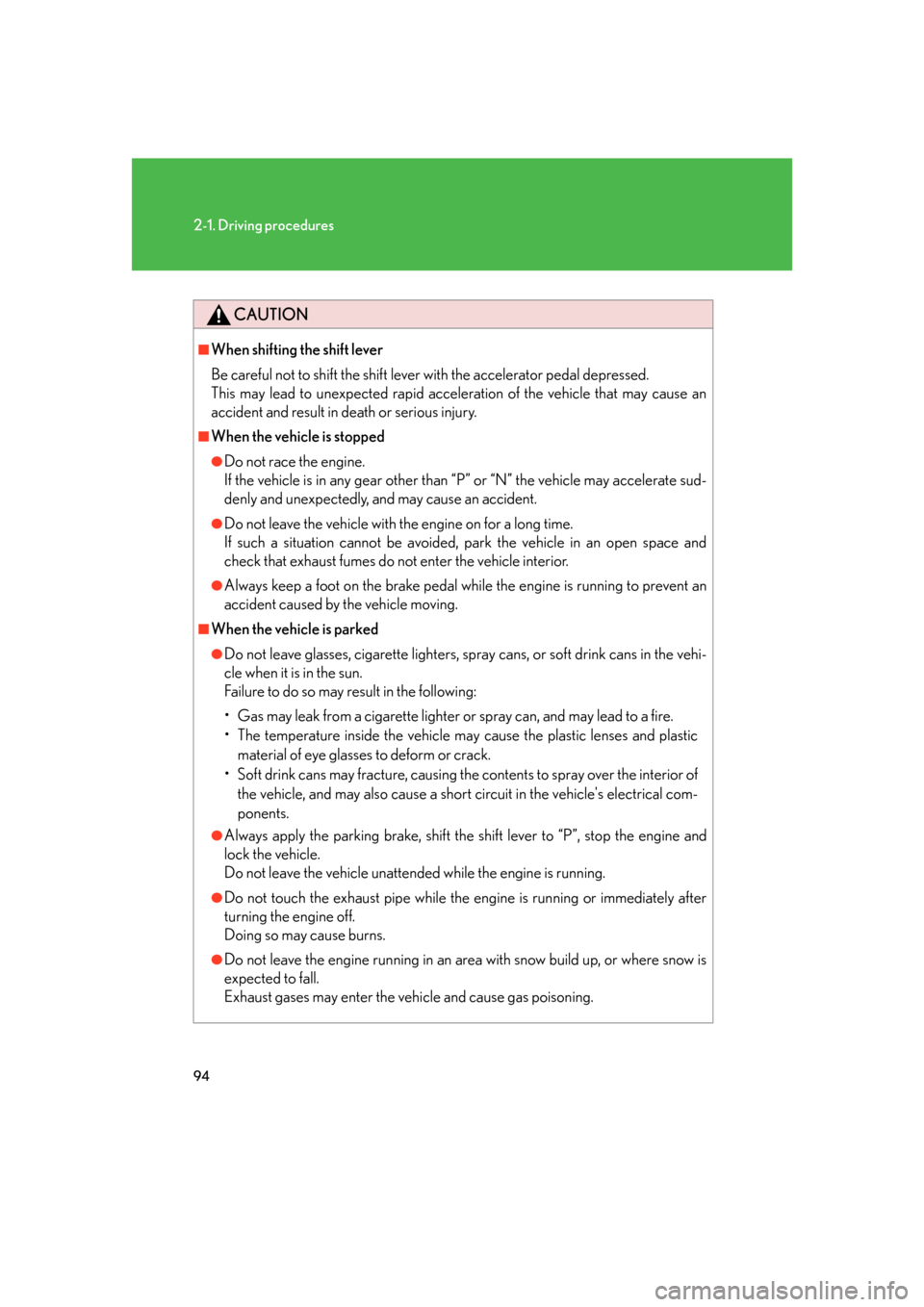
94
2-1. Driving procedures
CAUTION
■When shifting the shift lever
Be careful not to shift the shift lever with the accelerator pedal depressed.
This may lead to unexpected rapid acceleration of the vehicle that may cause an
accident and result in death or serious injury.
■When the vehicle is stopped
●Do not race the engine.
If the vehicle is in any gear other than “P” or “N” the vehicle may accelerate sud-
denly and unexpectedly, and may cause an accident.
●Do not leave the vehicle with the engine on for a long time.
If such a situation cannot be avoided, park the vehicle in an open space and
check that exhaust fumes do no t enter the vehicle interior.
●Always keep a foot on the brake pedal while the engine is running to prevent an
accident caused by the vehicle moving.
■When the vehicle is parked
●Do not leave glasses, cigarette lighters, spray cans, or soft drink cans in the vehi-
cle when it is in the sun.
Failure to do so may result in the following:
• Gas may leak from a cigarette lighter or spray can, and may lead to a fire.
• The temperature inside the vehicle may cause the plastic lenses and plastic material of eye glasses to deform or crack.
• Soft drink cans may fracture, causing the contents to spray over the interior of the vehicle, and may also cause a short circuit in the vehicle's electrical com-
ponents.
●Always apply the parking brake, shift the shift lever to “P”, stop the engine and
lock the vehicle.
Do not leave the vehicle unattend ed while the engine is running.
●Do not touch the exhaust pipe while the engine is running or immediately after
turning the engine off.
Doing so may cause burns.
●Do not leave the engine running in an area with snow build up, or where snow is
expected to fall.
Exhaust gases may enter the vehicle and cause gas poisoning.
Page 115 of 562
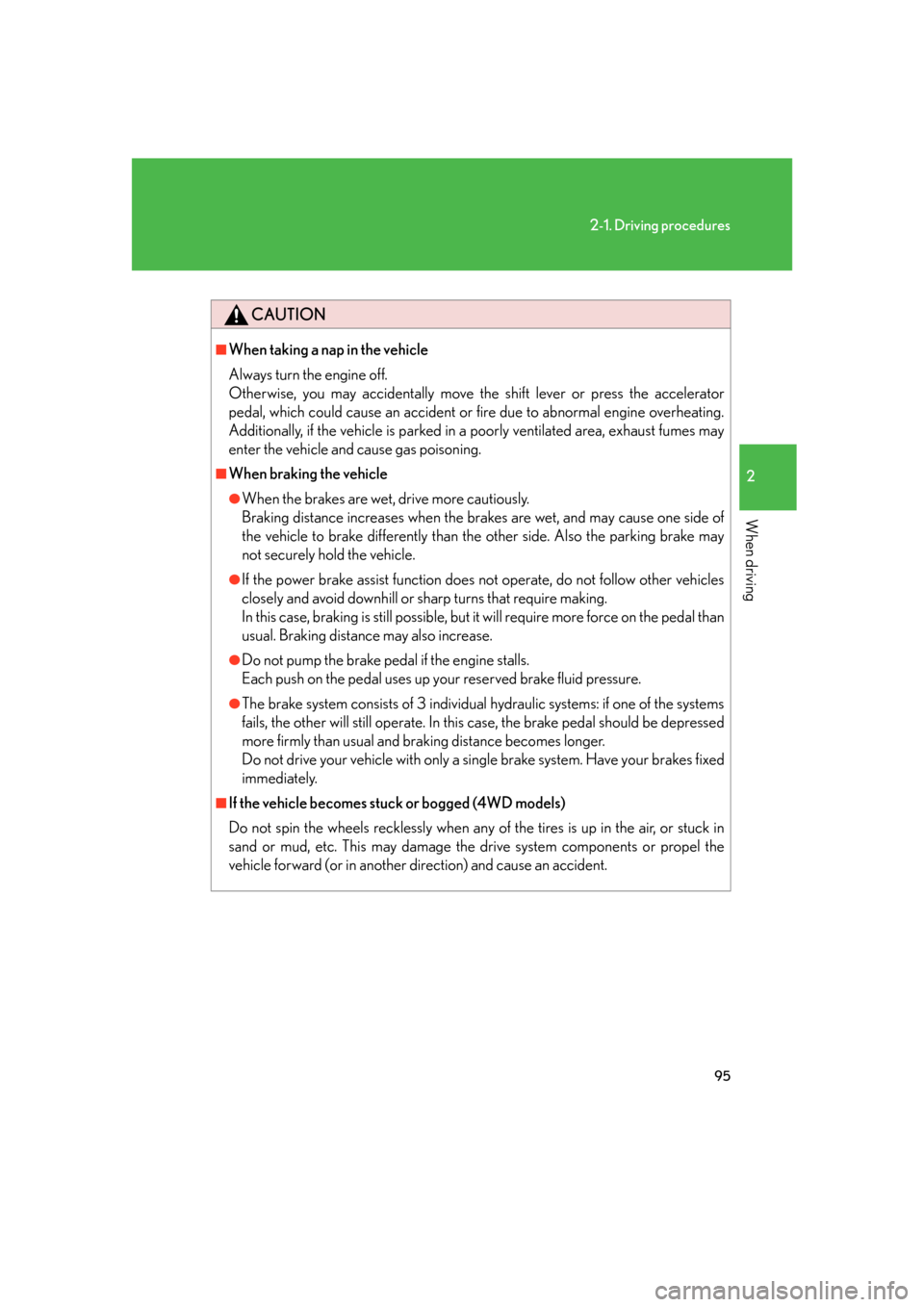
95
2-1. Driving procedures
2
When driving
CAUTION
■When taking a nap in the vehicle
Always turn the engine off.
Otherwise, you may accidentally move the shift lever or press the accelerator
pedal, which could cause an accident or fire due to abnormal engine overheating.
Additionally, if the vehicle is parked in a poorly ventilated area, exhaust fumes may
enter the vehicle and cause gas poisoning.
■When braking the vehicle
●When the brakes are wet, drive more cautiously.
Braking distance increases when the brakes are wet, and may cause one side of
the vehicle to brake differently than the other side. Also the parking brake may
not securely hold the vehicle.
●If the power brake assist function does not operate, do not follow other vehicles
closely and avoid downhill or sharp turns that require making.
In this case, braking is still possible, but it will require more force on the pedal than
usual. Braking distance may also increase.
●Do not pump the brake pedal if the engine stalls.
Each push on the pedal uses up yo ur reserved brake fluid pressure.
●The brake system consists of 3 individual hydraulic systems: if one of the systems
fails, the other will still operate. In this case, the brake pedal should be depressed
more firmly than usual and braking distance becomes longer.
Do not drive your vehicle with only a single brake system. Have your brakes fixed
immediately.
■If the vehicle becomes stuc k or bogged (4WD models)
Do not spin the wheels recklessly when any of the tires is up in the air, or stuck in
sand or mud, etc. This may damage the drive system components or propel the
vehicle forward (or in another direction) and cause an accident.
Page 117 of 562
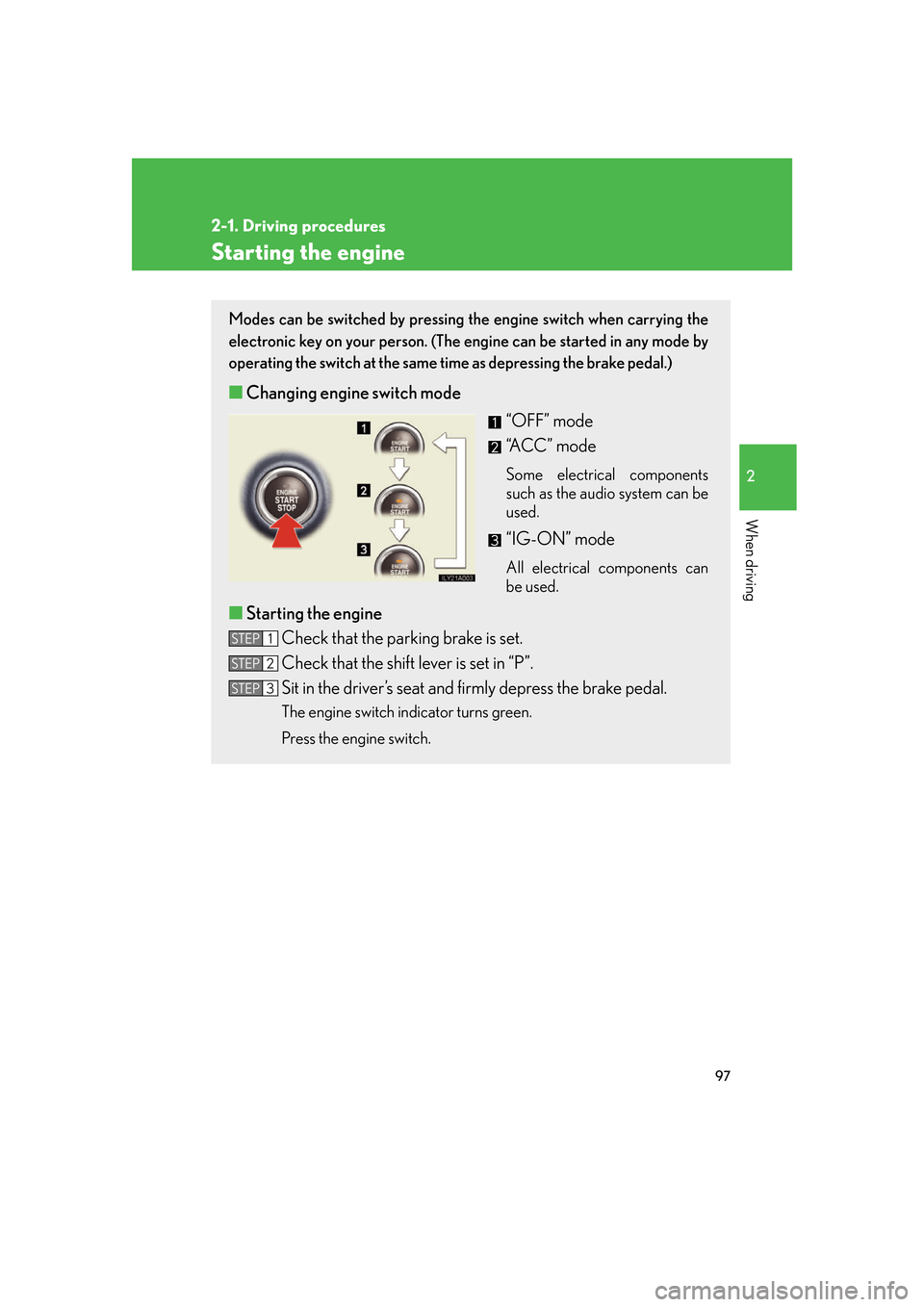
97
2-1. Driving procedures
2
When driving
Starting the engine
Modes can be switched by pressing the engine switch when carrying the
electronic key on your person. (The engine can be started in any mode by
operating the switch at the same time as depressing the brake pedal.)
■Changing engine switch mode
“OFF” mode
“A C C ” m o d e
Some electrical components
such as the audio system can be
used.
“IG-ON” mode
All electrical components can
be used.
■Starting the engine
Check that the parking brake is set.
Check that the shift lever is set in “P”.
Sit in the driver’s seat and firmly depress the brake pedal.
The engine switch indicator turns green.
Press the engine switch.
STEP1
STEP2
STEP3